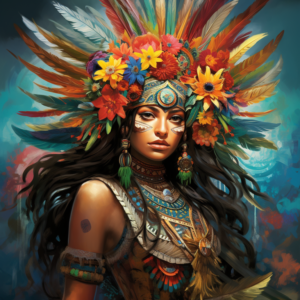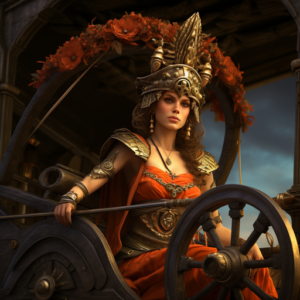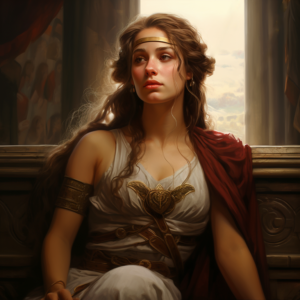Venus is the Roman goddess of femininity, love, beauty, and gardens. She embodied the female attributes of life. Venus was said to have had many romantic exploits with both gods and mortals. Today, she is mainly known as the goddess of love, but in the era of the Roman Empire she held many responsibilities including desire, lust, victory, and prostitution.
Origins
Princeton University explains that the creation of Venus in Roman mythology was not a traditional birth story. In the story of her birth, Venus’ father Uranus was castrated by his son, Cronus. Cronus was handed a stone sickle by his mother, Gala, who told her son to attack Uranus. After castrating his father, Cronus threw his reproductive organs into the sea, which caused the water to foam and helped create Venus.
Venus and the Greek goddess Aphrodite are similar goddesses who share many duties, powers, and responsibilities. The link between Venus and the Aphrodite dates back to the Ancient Greek religion, where Aphrodite was revered as the goddess of love.
Venus’ association with Aphrodite is likely tied to her connection with Jupiter. One temple to Venus was dedicated on August 18 or 19, the date of Jupiter’s festival called the Vinalia Rustica. She came to be seen as Jupiter’s daughter, and thus equated with his Greek counterpart’s daughter, Aphrodite. Venus had no myths of her own, and therefore took on those of Aphrodite and the various other goddesses with whom Aphrodite was associated.
Appearance
Venus is shown to be a beautiful young woman whose appearance reflects her role as the goddess of love and desire. In artworks from the ancient period and the later years, the appearance of Venus is of a beautiful woman with long flowing hair. The artwork featuring Venus often depicts her standing in a shell, which is a symbol she is closely associated with. The Ancient Encyclopedia explains the sexual reputation of Venus influenced artists who created artworks of her as a nude.

Family
Venus married Vulcan following the imprisonment of Juno by the blacksmith god. Juno had thrown her son, Vulcan, from the top of Mount Olympus because of his deformed features before he was found by a sea nymph. After reaching adulthood, Vulcan became an expert blacksmith capable of creating beautiful metalwork. The metal throne Juno ordered Vulcan to make imprisoned her and forced Jupiter to offer Vulcan the hand of Venus in return for Juno’s freedom.
The marriage of Venus and Vulcan was made difficult by the love of the goddess of love for Mars. One myth tells of Vulcan trapping Venus and Mars in a bed beneath a net, meaning the marriage of Vulcan and Venus would not produce children. Venus is a mother to several children, including Timur and Metes who became warriors with their father, Mars. Venus mothered children with several gods, including Mercury and Jupiter.
Symbols
The ocean birth of Venus led to a consistent link to the animals of the sea throughout the Roman period of history. The main symbol of Venus is the scallop shell that Venus is pictured standing in when she is painted by several artists. Venus is linked to several animals, including dolphins and doves, alongside her depiction alongside mirrors and girdles.
Taking her lead from Aphrodite, Venus is closely linked to different types of flowers. The flowers Venus is closely linked to include roses and myrtle, the latter used to decorate statues of Venus during Roman times. During the era of the Roman Empire, many married couples brought offerings of flowers to the temples dedicated to the following of Venus as an offering in return for advice about romance and fertility.
Powers & Duties
Over the history of the Roman Empire, Venus became increasingly important to the culture of the nation. Julius Ceasar eventually claimed her as an ancestor when she became known as the goddess of victory. The best-known duties of the goddess focus on her ability to provide love and fertility for married couples. Venus received offerings from married couples wanting to get married and live a happy life together.
Worship
The scholar Marcus Terentius Varro, who lived from 116 to 27 B.C., records that Venus was not mentioned in the oldest Roman records. This corresponds to the fact that she had no flamen, or special priests, and no Roman festival. She had, however, been worshiped by the Latins since ancient times, and two Latin temples were dedicated to her. Hence, she was later imported to Rome.
In 215 B.C., a temple to Venus Erycina was dedicated in Rome, and another was built in 181 B.C. The second temple came to be used by courtesans, prostitutes who served wealthy clients, often of the royal house. The day of its founding, April 23, was celebrated as the Vinalia Priora, also called dies meretricum, or “prostitutes’ day.”
A shrine to Venus Cloacina was located in the Forum Romanum. Cloacina is presumed to refer to the goddess of the Cloaca, the sewer drainage system that reduced ground water in the low-lying Forum, allowing the city to be built there. The association with Cloacina may have come from their shared symbol, the myrtle.

Worship of Venus peaked in Rome during the reign of the gens Iulia, the family of Julius Caesar, and also that of Augustus Caesar. Both claimed to have descended from Venus’ son Aeneas, who was said to have founded both Rome and the temple of Aphrodite in Eryx, Sicily. In 55 B.C., Roman triumvir Gnaeus Pompeius (General Pompey) dedicated a temple to Venus Victrix, “Bringer of Victory,” and Julius Caesar did the same for Venus Genetrix, the “Begetting Mother,” in 46 B.C. Venus was also honored at the temple of Mars Ultor. Even as late as 135 A.D., Hadrian built yet another temple to Venus Felix, the “Bringer of Success,” in Rome, near the Colosseum.
Venus’ amorous attributes were reflected among her worshipers. For example, a temple to Venus/Aphrodite was located in the Grecian city of Corinth. The phrase “to Corinthianize” came to mean “to practice immorality,” as sensual activities were a part of the worship of Venus in her temple on the Acrocorinthus hill. Lifestyles in Corinth were rife with “licentiousness (meaning sexually unrestrained behavior) and wanton luxury.”
Today
As with so many ancient deities, Venus’ legacy lives on in the naming of celestial objects. The second planet from the sun is called Venus, as is a spacecraft of the European Space Agency. The planet’s association with Venus dates to ancient Babylon, when the “star” was associated with Ishtar, another equivalent of Venus and Aphrodite.
The goddess’s role in romance has also had an effect on elements of popular culture. For example, beginning in ancient times and continuing through the Renaissance, Venus has been a popular subject in the fine arts due to her assumption of the greatest feminine beauty.
Facts about Venus
- She was the goddess of love and beauty, and of gardens and cultivated fields.
- She was the daughter of Jupiter and Dione, wife of Vulcan, lover of Mars and mother of Cupid and Aeneas.
- Venus was the Babylonian equivalent of Ishtar, the Phoenician equivalent of Astarte and the Greek equivalent of Aphrodite.
- In her different roles, she was called Venus Verticordia, Venus Erycina, Venus Victrix, Venus Genetrix, Venus Felix and Venus Cloacina.
- Under the name Venus Verticordia, this goddess was believed to protect the chastity of young girls and women. At other times, she was viewed as a patroness to prostitutes.
- Veneralia was a Roman festival dedicated to Venus Verticordia that was celebrated on April 1.
- A very famous statue called “Venus de Milo was found on the island of Melos, or Milos, thus giving the statue its name. It is well recognized for not having any arms. Today the statue is located at the Louvre in Paris.
- One of the most famous paintings of the goddess is called the “Birth of Venus”, by Sandro Botticelli. It portrays the goddess’ birth as coming to shore from the ocean in a giant shell. The painting is located at Uffizi Gallery in Florence, Italy.
- A romantic interest is compared to Venus in songs such as “Venus in Blue Jeans” by Bobby Vee, and the help of the goddess herself is invoked in Frankie Avalon’s “Venus”.
- Bananarama released a song titled “Venus” in 1986.
- Venus is also a popular brand of women’s hygiene items.
- A Venus automobile was built in the 1950’s. Only 10 were originally produced, and today only two still exist.
*As an Amazon Associate I earn from qualifying purchases.






